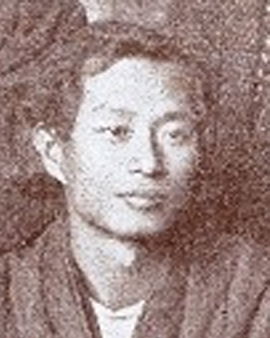Fine color gradations in woodblock prints - this is something that was rather unusual at the beginning of the last century. The Japanese artist Yoshida Hiroshi established this type of print; he is known for his woodblock prints, which develop their special effect through fine color gradations. Before he devoted himself entirely to woodblock prints in 1920, he created watercolors that also thrive on fine color gradations. He adopted this technique of color shading in his woodblock prints, which were produced with up to 60 printing processes per finished image. Only in this way was it possible for Yoshida Hiroshi to implement the fine gradations in the woodblock print. He founded his own print shop in 1925 to be able to realize his ideas exactly.
The Japanese artist's main focus was on landscape depictions, capturing his motifs in Japan and around the world. Frequent motif of his Japanese prints is Mount Fuji in different perspectives and at different seasons - such as in spring during Hanami, the cherry blossom. The variety of motifs in Yoshida Hiroshi's woodblock prints is fed by the many journeys he undertook throughout his life. After the Great Kanto Earthquake in 1923, the artist traveled to the United States and then on to Europe. Later, he set out for Southeast Asia and India, which also enriched the variety of motifs in his works. Looking at Yoshida Hiroshi's watercolors and woodblock prints, one quickly notices the fine gradations of color in his woodblock prints. While woodblock prints are usually characterized by simple, clear colors and contours, the prints of the Japanese artist clearly stand out. The landscape depictions appear natural and perfectly capture the play of light and shadow. As a result, the woodblock prints seem alive and have a certain depth. While clear color tones often make woodblock works look rather flat and striking, Yoshida Hiroshi adds a new dimension to his paintings with the help of the numerous color gradations.
Although the woodblock prints are attributed to the Shin-hanga movement, they differ greatly from works by other artists of the same movement because of the print execution. In addition, the prints of Yoshida Hiroshi are characterized by a more Western style, which was established during his many trips to the United States and Europe. Namely, the artist also practiced European oil painting. In addition, he often used the same printing blocks and applied different shades of color to them in order to depict one and the same motif in different light moods, such as the Taj Mahal in India. Today, Yoshida Hiroshi's atmospheric woodblock prints can be found in numerous museums around the world, such as the British Museum, the Portland Art Museum, and the Harvard Arts Museums.
×





 - (MeisterDrucke-12375).jpg)
 - (MeisterDrucke-12375).jpg)
_-_(MeisterDrucke-1455723).jpg)
_-_(MeisterDrucke-1455723).jpg)
.jpg)
.jpg)
.jpg)
.jpg)
.jpg)
.jpg)
.jpg)
.jpg)
.jpg)
.jpg)
.jpg)
.jpg)
.jpg)
.jpg)
.jpg)
.jpg)
.jpg)
.jpg)
.jpg)
.jpg)
.jpg)
.jpg)
.jpg)
.jpg)
.jpg)
.jpg)
.jpg)
.jpg)
.jpg)
.jpg)
.jpg)
.jpg)
.jpg)
.jpg)
.jpg)
.jpg)
.jpg)
.jpg)
_-_(MeisterDrucke-1448495).jpg)
_-_(MeisterDrucke-1448495).jpg)
.jpg)
.jpg)
.jpg)
.jpg)
.jpg)
.jpg)
.jpg)
.jpg)
.jpg)
.jpg)
_-_(MeisterDrucke-1455194).jpg)
_-_(MeisterDrucke-1455194).jpg)
_-_(MeisterDrucke-1408313).jpg)
_-_(MeisterDrucke-1408313).jpg)
.jpg)
.jpg)
.jpg)
.jpg)
.jpg)
.jpg)
.jpg)
.jpg)
.jpg)
.jpg)
.jpg)
.jpg)
_-_(MeisterDrucke-1449742).jpg)
_-_(MeisterDrucke-1449742).jpg)
.jpg)
.jpg)
.jpg)
.jpg)
.jpg)
.jpg)
.jpg)
.jpg)
.jpg)
.jpg)
.jpg)
.jpg)
_(colour_woodblock_print)_-_(MeisterDrucke-1408732).jpg)
_(colour_woodblock_print)_-_(MeisterDrucke-1408732).jpg)
.jpg)
.jpg)
.jpg)
.jpg)
.jpg)
.jpg)
.jpg)
.jpg)
.jpg)
.jpg)
.jpg)
.jpg)
.jpg)
.jpg)
.jpg)
.jpg)
.jpg)
.jpg)
.jpg)
.jpg)
.jpg)
.jpg)
_from_the_series_Twelve_Scenes_of_Tokyo_Taisho_e_-_(MeisterDrucke-1404471).jpg)
_from_the_series_Twelve_Scenes_of_Tokyo_Taisho_e_-_(MeisterDrucke-1404471).jpg)
.jpg)
.jpg)
.jpg)
.jpg)
.jpg)
.jpg)
.jpg)
.jpg)
.jpg)
.jpg)
_-_(MeisterDrucke-1400221).jpg)
_-_(MeisterDrucke-1400221).jpg)
.jpg)
.jpg)
.jpg)
.jpg)
.jpg)
.jpg)
_-_(MeisterDrucke-1403564).jpg)
_-_(MeisterDrucke-1403564).jpg)
.jpg)
.jpg)
.jpg)
.jpg)
.jpg)
.jpg)
_-_(MeisterDrucke-1413369).jpg)
_-_(MeisterDrucke-1413369).jpg)
_-_(MeisterDrucke-1455722).jpg)
_-_(MeisterDrucke-1455722).jpg)
.jpg)
.jpg)
.jpg)
.jpg)
.jpg)
.jpg)
_-_(MeisterDrucke-1408312).jpg)
_-_(MeisterDrucke-1408312).jpg)
.jpg)
.jpg)
.jpg)
.jpg)
.jpg)
.jpg)
.jpg)
.jpg)
.jpg)
.jpg)
.jpg)
.jpg)
.jpg)
.jpg)
.jpg)
.jpg)
_-_(MeisterDrucke-1404432).jpg)
_-_(MeisterDrucke-1404432).jpg)
_-_(MeisterDrucke-1409020).jpg)
_-_(MeisterDrucke-1409020).jpg)
.jpg)
.jpg)
.jpg)
.jpg)
.jpg)
.jpg)
.jpg)
.jpg)
_-_(MeisterDrucke-1449743).jpg)
_-_(MeisterDrucke-1449743).jpg)
.jpg)
.jpg)
.jpg)
.jpg)
.jpg)
.jpg)






